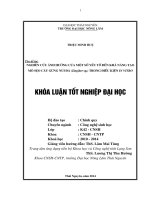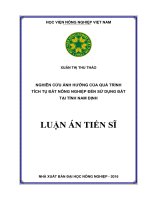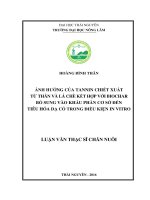ẢNH HƯỞNG CỦA DỊCH TRÍCH CÂY TỪ BI (BLUMÉA BALSAMIFERA) LÊN SỰ ỨC CHẾ HÌNH THÀNH TINH THỂ CALCIUM OXALATE GÂY BỆNH SỎI THẬN TRONG ĐIỀU KIỆN IN VITRO
Bạn đang xem bản rút gọn của tài liệu. Xem và tải ngay bản đầy đủ của tài liệu tại đây (246.64 KB, 11 trang )
<span class='text_page_counter'>(1)</span><div class='page_container' data-page=1>
<b>INHIBITION OF CALCIUM OXALATE CRYSTALLIZATION </b>
<b>CAUSING KIDNEY STONES IN VITRO BY AN EXTRACT OF </b>
<i><b>Bluméa balsamifera </b></i>
<b>Nguyen Pham Tuana*<sub>, Bang Hong Lam</sub>c<sub>, Nguyen Pham Tu</sub>a<sub>, Le Thao Nguyen</sub>b<sub>, </sub></b>
<b>Tran Duc Taib</b>
<i>a<sub>An Giang Biotechnology Center, An Giang, Vietnam </sub></i>
<i> b<sub>Gachon University, Seongnam, Gyeonggi, South Korea </sub></i>
<i>c<b><sub>An Giang University, An Giang, Vietnam </sub></b></i>
<i>*<sub>Corresponding author: Email: </sub></i>
<b>Article history </b>
Received: April 4th<sub>, 2020 </sub>
Received in revised form: September 28th<sub>, 2020 | Accepted: October 26</sub>th<sub>, 2020 </sub>
Available online: February 5th<sub>, 2021 </sub>
<b>Abstract </b>
<i>The inhibitory effect of Bluméa balsamifera extract on the nucleation, growth, and </i>
<i>aggregation phases of calcium oxalate formation has been studied. Plant samples were </i>
<i>extracted by the maceration method with 80.00% ethanol. The results showed that the </i>
<i>moisture content of Bluméa balsamifera extract was 82.83% and the yield was 5.79%. </i>
<i>Bluméa balsamifera extract contains bioactive compounds including alkaloids, flavonoids, </i>
<i>saponins, terpenoids, tannins, and phenol. Bluméa balsamifera extract has the ability to </i>
<i>inhibit the nucleation of calcium oxalate with an IC50 value of 4.25 mg/ml. Bluméa </i>
<i>balsamifera extract has a significant inhibitory effect on the growth of calcium oxalate </i>
<i>crystals with an IC50 value of 2.99 mg/ml. Finally, Bluméa balsamifera extract is capable of </i>
<i>inhibiting the aggregation of calcium oxalate with an IC50 value of 2.56 mg/ml. </i>
<i><b>Keywords: Aggregation; Bluméa balsamifera; Calcium oxalate; Growth; Nucleation. </b></i>
DOI:
Article type: (peer-reviewed) Full-length research article
Copyright © 2021 The author(s).
</div>
<span class='text_page_counter'>(2)</span><div class='page_container' data-page=2>
<b>1. </b> <b>INTRODUCTION </b>
Kidney stones are hard solid crystals formed in the kidney. The stones have five
forms: calcium oxalate, calcium phosphate, or a mixture of both crystals (accounting for
85% of monolithic and mixed forms), struvite, uric acid, and, rarely, cysteine. Calcium
oxalate crystals are the main component of more than 60% of kidney stones in humans.
The crystals exist in two main forms: calcium oxalate monohydrate (COM) and calcium
oxalate dihydrate (COD). In the human body, kidney stones have two sizes: small (< 5 mm)
and large (> 10 mm). The human body can pass the small stones without affecting health.
Conversely, large stones can clog the urinary tract causing pain (Atodariya et al., 2013).
In addition, medical therapy is effective in the treatment of calcium oxalate stones but has
a 50% risk of recurrence and many side effects, such as damage to blood vessels in the
kidneys and surrounding organs, etc. (Trần, 2016). According to traditional experience,
<i>the leaves of the compassion plant Bluméa balsamifera are capable of treating urinary </i>
diseases and kidney stones. Research by Charlimagne and Rizalinda (2017) indicates that
<i>Bluméa balsamifera extract has the ability to reduce the size of calcium oxalate crystals. </i>
From there, the subject: Inhibition of calcium oxalate crystallization causing kidney
<i>stones in vitro by an extract of Bluméa balsamifera to evaluate the effect of inhibiting the </i>
formation of calcium oxalate crystals causing kidney stones of medicinal plants, aiming
to create products with medicinal properties for prevention and treatment of diseases.
<b>2. </b> <b>MATERIALS AND METHODS </b>
<b>2.1. </b> <b>Materials </b>
<i>Leaves of Bluméa balsamifera were collected from a greenhouse at the An Giang </i>
Biotechnology Center. Chemicals and equipment, such as a freeze dryer,
spectrophotometer, sodium oxalate, Tris HCl, etc., were used.
<b>2.2. </b> <b>Methods </b>
<i>2.2.1. Sample preparation </i>
The plant material was cleaned with distilled water and damaged leaves were
removed. The material was shade dried with a freeze drier and then ground into powder
for extraction. The extracted powder (200 g) was soaked with 80% ethanol with the ratio
1 to 10 (w/v) at room temperature for 72 hours and then filtered through Whatman filter
paper No. 1. After the mixture was evaporated at 50 °C to remove solvent, the crude
extract was dried with a freeze drier and stored at -20 °C.
<i>2.2.2. Phytochemical screening of Bluméa balsamifera extract </i>
</div>
<span class='text_page_counter'>(3)</span><div class='page_container' data-page=3>
<i><b>Table 1. Screening method for bioactive compounds in the leaves of Bluméa </b></i>
<i><b>balsamifera extract </b></i>
Bioactive compound Methods Phenomenon
Alkaloids (Mayer) 1 ml extract + drops of Mayer’s reagent Brown precipitation
Flavonoids 1 ml extract + 2 ml Pb(OAc)4 10% Yellow precipitation
Saponins (Foam) 3 ml extract + 6 ml H2O → Heat Foam appearance
Steroids (Salkowski) 1 ml extract + 2 ml CHCl3 + 2 ml H2SO4 concentrated
Red brown appearance
between two layers
Tannins and phenol
(Braymer)
0.5 ml extract + 10 ml H2O + 2-3 drops of FeCl3
0.1% Blue precipitation
Terpenoids 2 ml extract + 2 ml (CH3CO)2O + 2-3 drops of
H2SO4 concentrated
Dark red color
appearance
<i>2.2.3. Nucleation assay </i>
The nucleation phase was initiated by adding calcium chloride 4 mM to sodium
oxalate 50 mM in the absence or presence of inhibitors (sodium citrate, extract) at
different concentrations (0.0625, 0.1250, 0.2500, 0.5000, 1.0000, 2.0000, 4.0000, 6.0000,
and 8.0000 mg/ml). Both solutions were prepared in a buffer containing TRIS 0.05M and
NaCl 0.15M at pH = 6.5. For the assay, 950 µl of calcium chloride was mixed with
various concentrations of the inhibitors or blank (100 µl), then 950 µl of sodium oxalate
was added and shaken well (Phatak & Hendre, 2015). The inhibition was determined by
measuring the absorbance of the mixture at 620 nm, and the percentage of inhibition was
calculated as:
%Inhibition = [(C-S)/C] x 100% (1)
where C is the optical density (OD) of the sample without inhibitors, and S is the
OD of the sample in the presence of inhibitors at different concentrations.
<b>The standard used to compare the efficacy of inhibiting nucleation, growth, and </b>
<b>aggregation of calcium oxalate crystallization is sodium citrate. Evaluation of its </b>
inhibitory effect is based on IC50.
<i>2.2.4. Growth assay </i>
</div>
<span class='text_page_counter'>(4)</span><div class='page_container' data-page=4>
surfaces. The reaction was monitored for 600 s, and the values were recorded every 60 s
(Chaudhary et al., 2010).
%Inhibition activity = [(C-S)/C] x 100% (2)
where C is the slope of the trend line without inhibitors, and S is the slope of the
trend line in the presence of inhibitors.
<i>2.2.5. Aggregation assay </i>
The CaOx crystals were prepared by mixing calcium chloride and sodium oxalate
at 50 mM. The solution was equilibrated in a water bath at 60 °C for 1 hour, then cooled
at 37 °C overnight to stabilize the crystals (i.e., not growing or dissolving in the solvent).
The crystals were harvested by centrifugation at 14,000 rpm and evaporation at 37 °<sub>C. </sub>
CaOx crystals were used at a final concentration of 1 mg/ml, buffered with TRIS 0.05 M
and 0.15 M at pH = 6.5. The sample without any extract was used as a control to compare
with various concentrations of inhibitors (extract and sodium citrate). The absorbance at
620 nm was recorded at 30, 60, 90, 180, and 360 minutes (Saha & Verma, 2013). The
percentage of inhibition was calculated as:
%Inhibition = (1-Si/Sc) x 100% (3)
where Si is the slope of the trend line in the presence of the inhibitors, and Sc is
the slope of the trend line without inhibitors.
IC50 definition: IC50 is the measure used to evaluate the strong or weak inhibitory
capacity of the sample. IC50 is defined as the concentration (mg/ml) of the sample that
can inhibit 50% of free radicals, cells, or enzymes. The more active the sample, the lower
the IC50 value will be.
How to determine IC50: An investigation of a sample's activity is conducted at
many different concentrations. For samples that vary linearly with concentration, draw a
line y = ax + b through all points (where y is % inhibition and x is concentration). For
samples that vary nonlinearly with concentration, choose two inhibitory concentrations
above and below 50% and draw a straight line to get the equation y = ax + b with known
coefficients a and b. From the known y = ax + b equation, replacing y = 50% in the equation
will yield the value of x, which is the 50% free radical inhibitory concentration (IC50).
<b>2.3. </b> <b>Statistical analysis </b>
</div>
<span class='text_page_counter'>(5)</span><div class='page_container' data-page=5>
<b>3. </b> <b>RESULTS AND DISCUSSION </b>
<b>3.1. </b> <i><b>The method of Bluméa balsamifera leaf </b></i>
<i>The extraction procedure was performed on leaves of Bluméa balsamifera </i>
<i>weighing 515 grams (dry). Moisture and yield of Bluméa balsamifera extract were </i>
82.83% and 5.79%, respectively (Table 2). Ethanol is the appropriate solvent for
extraction. If water is used as the sole solvent for extraction, the sample has a high risk of
contamination with organic acids, glucose, or protein, which are dissolved in the water,
thereby causing a negative effect to the bioactive compound qualitative or quantitative
process. Furthermore, if 96.00% ethanol is used as the sole solvent, the yield is decreased.
Therefore, 80.00% ethanol was used as the effective solvent for extraction because it gives
a high extraction productivity and removes all bacterial contamination (Bandar et al., 2013).
<i><b>Table 2. Extraction results of Bluméa balsamifera </b></i>
Evaluation Results
Fresh weight (g) 3,000.00
Moisture content (%) 82.83
Dry weight (g) 515.00
Extract weight (g) 29.83
Yielding extraction (%) 5.79
<b>3.2. </b> <i><b>Phytochemical screening of Bluméa balsamifera extract </b></i>
<i>Bluméa balsamifera extract contains bioactive compounds including alkaloids, </i>
flavonoids, saponins, terpenoids, tannins, and phenol (Table 3, Figure 1). Saponins,
flavonoids, and terpenoids have the ability to inhibit the formation and dissolution of
calcium oxalate crystals (Saranya & Geetha, 2014).
<b>Table 3. Bioactive compounds present in the extract </b>
Bioactive compound Results
Saponins +
Flavonoids +
Terpenoids +
Alkaloids +
Tannins and phenol +
Steroids -
</div>
<span class='text_page_counter'>(6)</span><div class='page_container' data-page=6>
Flavonoid Saponin Terpenoid
<b>Figure 1. Bioactive compounds present in the extract </b>
<b>Note: 1) Sample and reagent; 2) Water and reagent; 3) Extract and water. </b>
<b>3.3. </b> <b>Nucleation assay </b>
Citrate is a potential inhibitor for calcium oxalate stones because it forms a
complex with calcium, so the concentration of calcium oxalate will be decreased. In the
presence of citrate, the aggregation inhibition of urine macromolecules will be increased,
and the expression of urinary osteopontin, an important component of the protein matrix
of kidney stones, will be reduced (Gupta et al., 2011). Therefore, the inhibition activity
of citrate was used as a control to compare with that of extract.
The highest inhibition percentage in the nucleation assay was 88.10 ± 0.14% at
10.00 mg/ml of trisodium citrate, and the lowest inhibition percentage was 0.00% for the
distilled water control sample (Table 4). The IC50 value of sodium citrate for inhibition in
the nucleation assay was 1.16 mg/ml. The highest inhibition percentage in the nucleation
assay was 67.25 ± 0.15% at 10.00 mg/ml of extract, and the lowest inhibition percentage
was 0.00% for the distilled water control sample (Table 5). The IC50<i> value of Bluméa </i>
<i>balsamifera extract for inhibition in the nucleation assay was 4.25 mg/ml. </i>
<b>Table 4. Results of nucleation, growth, and aggregation inhibition of sodium citrate </b>
Concentration
(mg/ml)
Percent of nucleation
(%)
Percent of growth
(%)
Percent of aggregation
(%)
0.00 0l <sub>0</sub>l <sub>0</sub>l
0.25 30.42k <sub>± 0.39 </sub> <sub>29.29</sub>k <sub>± 0.56 </sub> <sub>20.60</sub>k <sub>± 0.65 </sub>
0.50 39.48h <sub>± 0.51 </sub> <sub>39.84</sub>h <sub>± 0.51 </sub> <sub>35.13</sub>h <sub>± 0.14 </sub>
0.75 45.42g <sub>± 0.42 </sub> <sub>44.55</sub>g <sub>± 0.55 </sub> <sub>40.11</sub>g <sub>± 0.22 </sub>
1.00 49.55f <sub>± 0.57 </sub> <sub>54.10</sub>f <sub>± 0.43 </sub> <sub>44.77</sub>f <sub>± 0.71 </sub>
2.00 53.47e <sub>± 0.47 </sub> <sub>59.70</sub>e <sub>± 0.56 </sub> <sub>49.99</sub>e <sub>± 0.80 </sub>
4.00 65.16d <sub>± 0.50 </sub> <sub>65.15</sub>d <sub>± 0.22 </sub> <sub>53.32</sub>d <sub>± 0.23 </sub>
6.00 75.29c <sub>± 0.46 </sub> <sub>69.98</sub>c <sub>± 0.12 </sub> <sub>57.18</sub>c <sub>± 0.47 </sub>
8.00 80.62b <sub>± 0.48 </sub> <sub>75.29</sub>b <sub>± 0.15 </sub> <sub>60.47</sub>b <sub>± 0.36 </sub>
10.00 88.10a <sub>± 0.14 </sub> <sub>79.97</sub>a <sub>± 0.21 </sub> <sub>63.61</sub>a <sub>± 0.13 </sub>
</div>
<span class='text_page_counter'>(7)</span><div class='page_container' data-page=7>
<i><b>Table 5. Results of nucleation, growth, and aggregation inhibition of Bluméa </b></i>
<i><b>balsamifera extract </b></i>
Concentration
(mg/ml)
Nucleation inhibiton
(%)
Growth inhibition
(%)
Aggregation inhibition
(%)
0.00 0l <sub>0</sub>l <sub>0</sub>l
0.25 15.21k <sub>± 0.15 </sub> <sub>13.58</sub>k <sub>± 0.05 </sub> <sub>14.53</sub>k <sub>± 0.11 </sub>
0.50 28.24h <sub>± 0.16 </sub> <sub>20.33</sub>h <sub>± 0.31 </sub> <sub>28.42</sub>h <sub>± 0.19 </sub>
0.75 34.88g <sub>± 0.23 </sub> <sub>21.49</sub>g <sub>± 0.19 </sub> <sub>34.23</sub>g <sub>± 0.08 </sub>
1.00 41.26f <sub>± 0.07 </sub> <sub>39.26</sub>f <sub>± 0.08 </sub> <sub>41.96</sub>f <sub>± 0.21 </sub>
2.00 45.16e <sub>± 0.09 </sub> <sub>46.32</sub>e <sub>± 0.22 </sub> <sub>49.65</sub>d <sub>± 0.13 </sub>
4.00 49.82d <sub>± 0.12 </sub> <sub>56.27</sub>c <sub>± 0.25 </sub> <sub>57.48</sub>b <sub>± 0.08 </sub>
6.00 53.93c <sub>± 0.30 </sub> <sub>62.85</sub>b <sub>± 0.05 </sub> <sub>61.19</sub>a <sub>± 0.06 </sub>
8.00 60.41b <sub>± 0.22 </sub> <sub>70.82</sub>a <sub>± 0.10 </sub> <sub>55.44</sub>c <sub>± 0.14 </sub>
10.00 67.25a <sub>± 0.25 </sub> <sub>51.89</sub>d <sub>± 0.23 </sub> <sub>47.35</sub>e <sub>± 0.25 </sub>
Note: In the same column, the values followed by the same character do not differ significantly by 5%.
The inhibitory effects on calcium oxalate crystallization were assessed using IC50
values. As a result, the IC50 value of 4.25 mg/ml for the extract was higher than the IC50
of 1.16 mg/ml for sodium citrate (Table 6) because sodium citrate can directly react with
calcium ions and immediately reduce the crystal density (Guptaet al., 2011). Nirmaladevi
<i>et al. (2012) found that Hibscus rosa-sinensis Linn flower extract inhibited nucleation by </i>
approximately 30.00% at a concentration of 1.40 mg/ml. Agarwal and Varma (2015)
<i>found that Achyranthes aspera L. extract inhibited nucleation by approximately 60.06 ± </i>
<i>0.19% at a concentration of 1.00 mg/ml. Trần (2016) found that Carmona microphylla L. </i>
extract was an inhibitor in the nucleation assay of calcium oxalate with a value of IC50 =
1.76 mg/ml.
<b>Table 6. Comparison of the IC50 value of calcium oxalate crystallization by sodium </b>
<i><b>citrate and Bluméa balsamifera extract </b></i>
No. Stage of inhibition of COM
IC50 (mg/ml)
Sodium citrate <i>Bluméa balsamifera extract </i>
1 Nucleation 1.16 4.25
2 Growth 0.89 2.99
3 Aggregation 2.68 2.56
<i>Bluméa balsamifera extract of ethanol has the ability to inhibit the formation of </i>
</div>
<span class='text_page_counter'>(8)</span><div class='page_container' data-page=8>
Therefore, low density COM crystals appear in the sample due to the flavonoid, saponin,
and terpenoid compounds contained in the extract.
<b>3.4. </b> <b>Growth assay </b>
The highest inhibition percentage in the growth assay was 79.97 ± 0.21% at
10.00 mg/ml of sodium citrate, and the lowest inhibition percentage was 0.00% for the
distilled water control (Table 4). The IC50 value of sodium citrate for inhibition in the
growth assay was 0.89 mg/ml. The highest inhibition percentage in the growth assay was
71.62 ± 0.44% at 8.00 mg/ml of extract, and the lowest inhibition percentage was 0.00%
for the distilled water control (Table 5). The IC50<i> value of Bluméa balsamifera extract for </i>
inhibition in the growth assay was 2.99 mg/ml.
The inhibitory effects of calcium oxalate crystallization were assessed by IC50
values. As a result, the IC50 value of 2.99 mg/ml for the extract was higher than the IC50
of 0.89 mg/ml for sodium citrate (Table 6) because sodium citrate can directly react with
calcium ions and immediately reduce the crystal density (Gupta et al., 2011). Trần (2016)
<i>found that Carmona microphylla L. extract inhibited calcium oxalate in a growth assay </i>
with a value of IC50 = 1.50 mg/ml.
<i>Bluméa balsamifera extract can inhibit the growth of calcium crystals by coating </i>
the surface of the crystals. Moreover, the bioactive compounds can interact and form a
complex with calcium and oxalate ions to inhibit the growth of the crystals (de Cógáin et
al., 2015). When the concentration of the extract reaches 10.00 mg/ml, the inhibition
percentage decreases because saponins and flavonoids can both transfer COM to COD,
increasing the formation of COD so the extract can easily pass through the renal tube
(Atmani & Khan, 2000).
<b>3.5. </b> <b> Aggregation assay </b>
The highest inhibition percentage in the aggregation assay was 63.61 ± 0.13% at
10.00 mg/ml of sodium citrate, and the lowest inhibition percentage was 0.00% for the
distilled water control sample (Table 4). The IC50 value of sodium citrate for inhibition in
the aggregation assay was 2.68 mg/ml. The highest inhibition percentage in the
aggregation assay was 72.19 ± 0.09% at 6 mg/ml of extract, and the lowest inhibition
percentage was 0.00% for the distilled water control sample (Table 5). The IC50 value of
<i>Bluméa balsamifera extract for inhibition in the aggregation assay was 2.56 mg/ml. </i>
The inhibitory effects on calcium oxalate crystallization were assessed by IC50
values. The IC50 value of 2.68 mg/ml for sodium citrate was higher than that of the extract
IC50, which was 2.56 mg/ml (Table 6). The reason is that sodium citrate has the ability to
</div>
<span class='text_page_counter'>(9)</span><div class='page_container' data-page=9>
<i>found that a 100.00% Ocimum gratissimum L. extract inhibited 62.07% of crystal </i>
<i>aggregation. Trần (2016) found that Carmona microphylla L. extract was an inhibitor of </i>
calcium oxalate in an aggregation assay with IC50 = 0.80 mg/ml.
Aggregation is a critical step in the stone formation process in which small crystals
form a cluster by strong chemical or electrical forces and increase in size (Nirmaladevi et
<i>al., 2012). The extract Bluméa balsamifera had the highest inhibition percentage because </i>
the bioactive compound coated the surface of the crystals to prevent aggregation (Pareta
et al., 2011). Moreover, saponins and terpenoids can inhibit crystal aggregation by
interacting with mucoprotein, the primary factor causing the supersaturation of calcium
oxalate crystals, which initiates the stone formation process (Saha & Verma, 2013).
However, at 8.00 mg/ml and 10.00 mg/ml, the inhibitory percentage was lower than 6.00
mg/ml, because the extract promotes the formation of COD. COD can easily be extracted
through the renal tubes without any risk from the kidney stone (Atmani & Khan, 2000).
The IC50 index of the extract (2.56 mg/ml) was lower than that of sodium oxalate (2.68
mg/ml) because the main inhibitory effect of sodium citrate is focused on the growth
phase (Gupta et al., 2011).
The results of investigating the ability to inhibit the formation of crystals of
calcium oxalate in the three main phases, nucleation, growth, and aggregation, were IC50
values of 4.25, 2.99, and 2.56 mg/ml, respectively. The research results show that the
extract of the compassion plant has the ability to inhibit the formation of crystals of
calcium oxalate, which is also consistent with the study of Charlimagne and Rizalinda
(2017) that the extract of the compassion plant is capable of reducing the size of calcium
oxalate crystals with a dosage of extract of 0.50 mg/mL and 1.00 mg/ml. Research results
show that compassion plant extract can be a raw material source for products to treat
diseases, especially diseases related to kidney stones.
<b>4. </b> <b>CONCLUSIONS </b>
<i>Bluméa balsamifera extract has a significant inhibitory effect on the nucleation, </i>
growth, and aggregation of calcium oxalate crystallization, which causes kidney stones.
<i>Further study on Bluméa balsamifera extract on the in vivo model of calcium oxalate </i>
<i>inhibition. Separation and purification of bioactive compounds from Bluméa balsamifera </i>
have the potential to treat kidney stones.
<b>ACKNOWLEDGMENTS </b>
Thanks to An Giang Biotechnology Center and An Giang Department of Science
and Technology for facilitating and supporting this research.
<b>REFERENCES </b>
Agarwal, K., & Varma, R. (2015). In-vitro calcium oxalate crystallization inhibition by
</div>
<span class='text_page_counter'>(10)</span><div class='page_container' data-page=10>
<i>Atmani, F., & Khan, S. R. (2000). Effects of an extract from Herniaria hirsuta on calcium </i>
<i>oxalate crystallization in vitro. BJU International, 85(6), 621-625. </i>
Atodariya, U., Barad, R., Upadhyay, S., & Upadhyay, U. (2013). Anti-Urolithiatic
<i>activity of Dolichos biflorus seeds. Journal of Pharmacognosy and </i>
<i>Phytochemistry, 2(2), 209-213. </i>
Bandar, H., Hijazi, A., Rammal, H., Hachem, A., Saad, Z., & Badran, B. (2013).
<i>Techniques for the extraction of bioactive compounds from Lebanese Urtica </i>
<i>dioica. American Journal of Phytomedicine and Clinical Therapeutics, 6, 507-513. </i>
<i>Charlimagne, M. M., & Rizalinda, L. D. L. (2017). Effect of Blumea balsamifera extract </i>
<i>on the phase and morphology of calcium oxalate crystals. Asian Journal of </i>
<i><b>Urology, 4(4), 201-207. </b></i>
<i>Chaudhary, A., Singla, S. K., & Tandon, C. (2010). In vitro evaluation of Terminalia </i>
<i>arjuna on calcium phosphate and calcium oxalate crystallization. Indian Journal </i>
<i>of Pharmaceutical Sciences, 72(3), 340-345. </i>
de Cógáin, M. R., Linnes, M. P., Lee, H. J., Krambeck, A. E., de Mendonỗa Uchụa, J. C.,
<i>Kim, S. H., & Lieske, J. C. (2015). Aqueous extract of Costus arabicus inhibits </i>
calcium oxalate crystal growth and adhesion to renal epithelial
<i>cells. Urolithiasis, 43(2), 119-124. </i>
Gupta, M., Bhayana, S., & Sikka, S. K. (2011). Role of urinary inhibitors and promoters
<i>in calcium oxalate crystallisation. International Journal of Research in Pharmacy </i>
<i>and Chemistry, 1(4), 793-798. </i>
Nirmaladevi, R., Kavitha, D., & Padma, P. R. (2012). Evaluation of antilithiatic potential
<i>of Hibiscus rosa-sinensis Linn, in vitro. Journal of Pharmacy Research, 5(8), </i>
4353-4356.
Pareta, S. K., Prata, K. C., & Ranjit, K. H. (2011). In-vitro calcium oxalate crystallization
<i>inhibition by Achyranthes indica Linn. Hydroalcoholic extract: An approach to </i>
<i>antilithiasis. International Journal of Pharma and Bio Sciences, 2(1), 432-437. </i>
<i>Phatak, R. S., & Hendre, A. S. (2015). In-vitro antiurolithiatic activity of Kalanchoe </i>
<i>pinnata extract. International Journal of Pharmacognosy and Phytochemical </i>
<i>Research, 7(2), 275-279. </i>
Saha, S., & Verma, R. J. (2013). Inhibition of calcium oxalate crystallisation in vitro by
<i>an extract of Bergenia ciliata. Arab Journal of Urology, 11(2), 187-192. </i>
Saranya, R., & Geetha, N. (2014). Inhibition of calcium oxalate (CaOx) crystallization in
<i>vitro by the extract of beet root (Beta vulgaris L.). International Journal of </i>
<i>Pharmacy and Pharmaceutical Sciences, 6(2), 361-365. </i>
<i>Trần, Đ. T. (2016). Ảnh hưởng của dịch trích lá và thân cây Bùm sụm (Carmona </i>
</div>
<span class='text_page_counter'>(11)</span><div class='page_container' data-page=11>
Vyawahare, J. N., Shelke, P. A., Aragade, P. D., & Baheti, D. G. (2014). Inhibition of
<i>calcium oxalate crystallization in vitro by extract of Momordica charantia Linn. </i>
<i>International Journal of Pharmaceutical and Chemical Sciences, 3(2), 448-452. </i>
Yadav, M., Chatterji, S., Gupta, S. K., & Watal, G. (2014). Preliminary phytochemical
<i>screening of six medicinal plants used in traditional medicine. International </i>
</div>
<!--links-->









